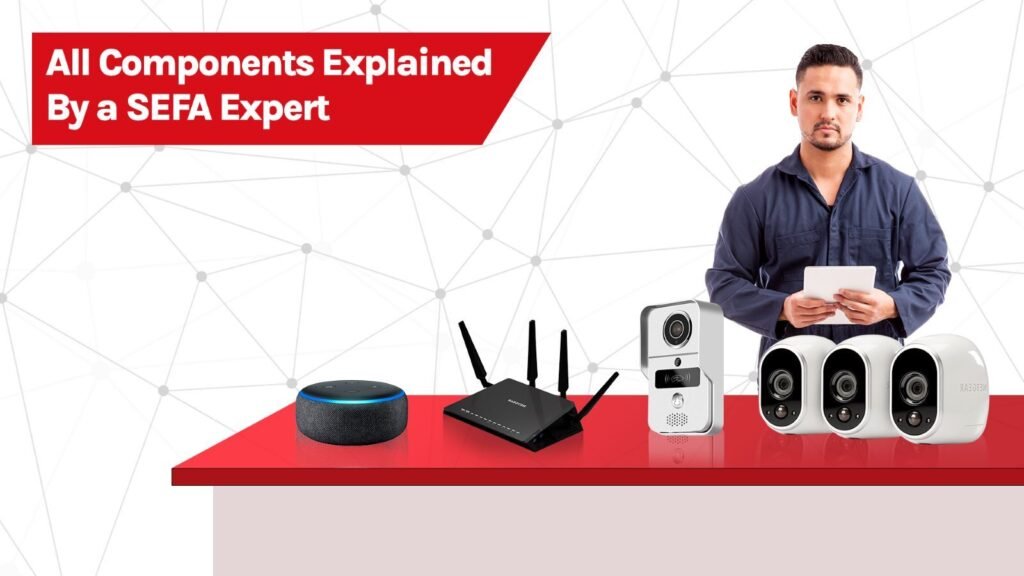
Homeowners in Dubai are increasingly adopting smart home technologies to enhance comfort, safety, and control. Upgrading an existing property or integrating automation into a new build both require a solid understanding of the components of a home automation system to ensure informed decisions and optimal results.
This guide outlines the core elements that enable a functional and efficient smart home system. Each component is explained in simple terms to help readers ensure a smooth automation experience.
Smart home defines as “a network of smart devices and technologies that let you control your home from anywhere. You can automate lights, doors, ACs, cameras, and other electronics using mobile apps, voice assistants, or smart routines.”
These ELV systems improve:
- Convenience
- Energy savings
- Security
- Comfort
Main Components of a Home Automation System
Here are the key parts that make up a smart home:
1. Smart Hub or Central Controller
This is the brain of your smart home. It connects and controls all your devices.
- It helps devices communicate with each other.
- Popular hubs: Google Nest Hub, Amazon Echo, Samsung SmartThings.
- You can use one app to manage all your devices through the hub.
Tip: Choose a hub that supports most devices and protocols.
2. Smart Sensors
Sensors are small devices that detect changes and send signals to the system.
Types of sensors:
- Motion sensors: Detect movement (used for lights, alarms).
- Door/window sensors: Notify when doors/windows are opened.
- Temperature sensors: Adjust AC or heating.
- Light sensors: Control lighting based on sunlight.
- Smoke/gas detectors: Alert during fire or leaks.
Sensors make your home responsive. For example, you enter in a room? The light turns on.
Read more about popular home automation gadgets.
3. Actuators
Actuators are devices that perform physical actions based on sensor signals.
Examples:
- Smart locks that lock/unlock doors
- Smart curtains that open with sunlight
- Smart valves that control water
They are the hands of your system, reacting to commands or automation.
4. Smart Devices and Appliances
These are the visible parts of your smart home. You use them daily.
Common smart devices include:
- Smart lights: Dimmable, color-changing, scheduled.
- Smart thermostats: Save energy by adjusting temperature automatically.
- Smart plugs and sockets: Turn any device into a smart device.
- Smart TVs and speakers: Connect with apps and voice assistants.
- Smart fridges, ovens, washing machines: Controlled remotely or by schedule.
Smart devices make your life easier and save time.
5. Communication Protocols
These are the technologies that allow devices to talk to each other.
Popular protocols:
- Wi-Fi: Fast but can slow down with many devices.
- Zigbee: Low power, good for smart lighting.
- Z-Wave: Reliable and secure for home automation.
- Bluetooth: Good for close-range control.
- Thread: New and fast-growing, designed for smart homes.
Choosing the right protocol ensures smooth performance.
6. Mobile App or Control Dashboard
This is your command center. The app lets you:
- View device status
- Turn devices on/off
- Set automation rules
- Monitor security cameras
Most systems have apps for both Android and iOS.
Popular apps:
- Google Home
- Apple Home
- Alexa App
- SmartThings
A good app should be easy to use, fast, and secure.
7. Cloud Connectivity and Internet Access
Smart homes need internet to work remotely. Cloud services allow you to:
- Access your home from anywhere
- Get alerts and notifications
- Store camera footage
- Use voice commands through Alexa or Google
Without the internet, your system may work locally, but remote control won’t be possible.
Additional Components Use in Building Smart Homes
1. Voice Assistants
These allow you to control your home by voice.
- Amazon Alexa
- Google Assistant
- Apple Siri
You can say, “Turn off the lights,” and it will be done.
2. Smart Security Cameras
- Watch live footage from anywhere
- Get alerts on motion
- Store recordings in the cloud
3. Smart Doorbells
- See and talk to visitors from your phone
- Useful for deliveries and guest management
4. Smart Curtain Motors and Blinds
- Open or close based on time or sunlight
- Improve privacy and energy control
5. Smart Irrigation Systems
- Automatically water your garden based on weather and schedule
How These Components of Smart home Systems Work Together
Here’s a simple example:
- Motion is detected in the hallway.
- The sensor sends a signal to the hub.
- The hub tells the smart light to turn on.
- All of this happens in 1-2 seconds.
You can also set routines, like:
- “When you leave home, turn off all lights, lock doors, and activate security.”
Everything works together to make your home smart, safe, and simple.
Why Understanding Components is Important
Knowing the parts of a home automation system helps you:
- Plan better installations
- Choose compatible devices
- Avoid connection issues
- Save money on unnecessary features
Closing Words
A home automation system is not just a trend. It’s a smarter, safer, and more efficient way to live. Knowing the key components helps you build a system that works smoothly.
If you have any questions or want to get started, contact SEFA for reliable home automation installation. Let’s make your Dubai home smarter, together.


